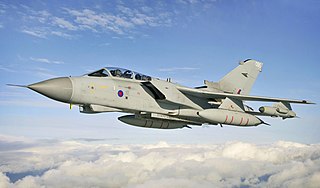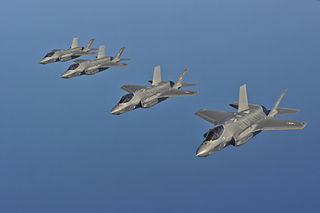
The Eurofighter Typhoon is a European multinational twin-engine, canard delta wing, multirole fighter. The Typhoon was designed originally as an air superiority fighter and is manufactured by a consortium of Airbus, BAE Systems and Leonardo that conducts the majority of the project through a joint holding company, Eurofighter Jagdflugzeug GmbH. The NATO Eurofighter and Tornado Management Agency, representing the UK, Germany, Italy and Spain, manages the project and is the prime customer.

The Panavia Tornado is a family of twin-engine, variable-sweep wing multirole combat aircraft, jointly developed and manufactured by Italy, the United Kingdom and West Germany. There are three primary Tornado variants: the Tornado IDS (interdictor/strike) fighter-bomber, the suppression of enemy air defences Tornado ECR and the Tornado ADV interceptor aircraft.

The Panavia Tornado Air Defence Variant (ADV) was a long-range, twin-engine interceptor version of the swing-wing Panavia Tornado. The aircraft's first flight was on 27 October 1979, and it entered service with the Royal Air Force (RAF) in 1986. It was also operated by the Italian Air Force (AMI) and the Royal Saudi Air Force (RSAF).

The Saab 35 Draken is a Swedish fighter-interceptor developed and manufactured by Svenska Aeroplan Aktiebolaget (SAAB) between 1955 and 1974. Development of the Saab 35 Draken started in 1948 as the Swedish air force future replacement for the then also in development Saab 29 Tunnan dayfighter and Saab 32B Lansen night fighter. It featured an innovative but unproven double delta wing, which led to the creation of a sub-scale test aircraft, the Saab 210, which was produced and flown to test this previously-unexplored aerodynamic feature. The full-scale production version entered service with frontline squadrons of the Swedish Air Force on 8 March 1960. It received the designation Flygplan 35 and was produced in several variants and types, most commonly as a fighter type with the prefix J, standing for Jaktflygplan (Pursuit-aircraft), the Swedish term for fighter aircraft.

The IRIS-T is a German-led program to develop a short-range infrared homing air-to-air missile to replace the AIM-9 Sidewinder found in some NATO member countries. Any aircraft capable of firing the Sidewinder is also capable of launching the IRIS-T.

An air-to-air missile (AAM) is a missile fired from an aircraft for the purpose of destroying another aircraft. AAMs are typically powered by one or more rocket motors, usually solid fueled but sometimes liquid fueled. Ramjet engines, as used on the Meteor, are emerging as propulsion that will enable future medium-range missiles to maintain higher average speed across their engagement envelope.

The BK 27 is a 27 mm (1.063 in) caliber revolver cannon manufactured by Mauser of Germany. It was developed in the late 1960s for the MRCA program that ultimately became the Panavia Tornado.

Panavia Aircraft GmbH is a German company established by the three partner states of the Tornado Multi Role Combat Aircraft (MRCA) project: West Germany, Italy and the UK.

An electronic countermeasure (ECM) is an electrical or electronic device designed to trick or deceive radar, sonar, or other detection systems, like infrared (IR) or lasers. It may be used both offensively and defensively to deny targeting information to an enemy. The system may make many separate targets appear to the enemy, or make the real target appear to disappear or move about randomly. It is used effectively to protect aircraft from guided missiles. Most air forces use ECM to protect their aircraft from attack. It has also been deployed by military ships and recently on some advanced tanks to fool laser/IR guided missiles. It is frequently coupled with stealth advances so that the ECM systems have an easier job. Offensive ECM often takes the form of jamming. Self-protecting (defensive) ECM includes using blip enhancement and jamming of missile terminal homers.

The Skyflash, or Sky Flash in marketing material, was a medium-range semi-active radar homing air-to-air missile derived from the US AIM-7 Sparrow missile and carried by Royal Air Force McDonnell Douglas F-4 Phantoms and Tornado F3s, Italian Aeronautica Militare and Royal Saudi Air Force Tornados and Swedish Flygvapnet Saab Viggens.

The German Air Force is the aerial warfare branch of the Bundeswehr, the armed forces of Germany. The German Air Force was founded in 1956 during the era of the Cold War as the aerial warfare branch of the armed forces of then West Germany. After the reunification of West and East Germany in 1990, it integrated parts of the air force of the former German Democratic Republic, which itself had been founded in 1956 as part of the National People's Army. There is no organizational continuity between the current German Air Force and the former Luftwaffe of the Wehrmacht founded in 1935, which was completely disbanded in 1945/46 after World War II. The term Luftwaffe that is used for both the historic and the current German air force is the German-language generic designation of any air force.

The Hughes AIM-4 Falcon was the first operational guided air-to-air missile of the United States Air Force. Development began in 1946; the weapon was first tested in 1949. The missile entered service with the USAF in 1956.
An active protection system is a system designed to prevent anti-tank missiles/projectiles from acquiring and/or destroying a target.

An infrared countermeasure (IRCM) is a device designed to protect aircraft from infrared homing missiles by confusing the missiles' infrared guidance system so that they miss their target. Heat-seeking missiles were responsible for about 80% of air losses in Operation Desert Storm. The most common method of infrared countermeasure is deploying flares, as the heat produced by the flares creates hundreds of targets for the missile.

A multirole combat aircraft (MRCA) is a combat aircraft intended to perform different roles in combat. These roles can include air to air combat, aerial bombing, reconnaissance, electronic warfare, and suppression of air defenses.

Chemring Group is a global business providing a range of advanced technology products and services to the aerospace, defence and security markets. Chemring has extensive operations in the Americas, Europe, Middle East and Asia.
Jet fighter generations classify the major technology leaps in the historical development of the jet fighter. Different authorities have identified different technology jumps as the key ones, dividing fighter development into different numbers of generations. Five generations are now widely recognised, with development of a sixth under way.

The Leonardo's Praetorian DASS is an integral part of Eurofighter Typhoon defensive Aid Sub-System (DASS) providing threat assessment, aircraft protection and support measures in extremely hostile and severe environments. As the DASS is fully integrated, it does not require additional pods that take up weapon stations or would influence the aircraft's aerodynamic performance. In addition the modular nature of the DASS simplifies future upgrades and allows each partner nation or export customer the option to tailor the DASS to their individual needs.
















